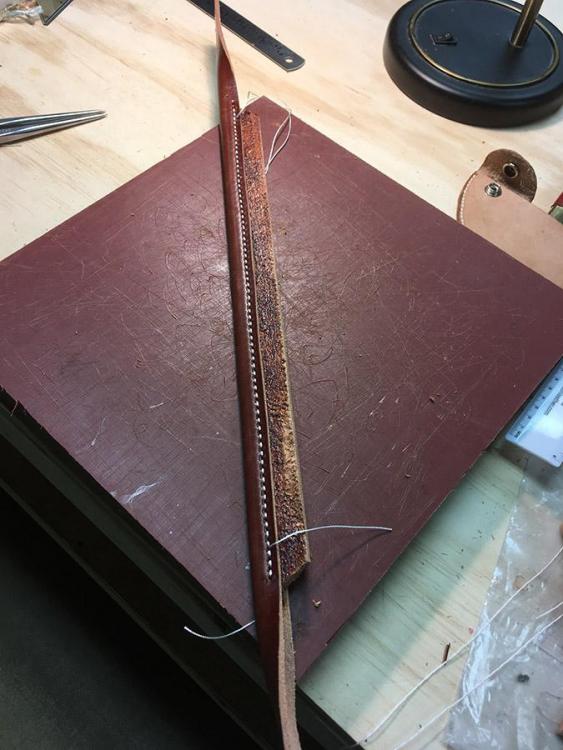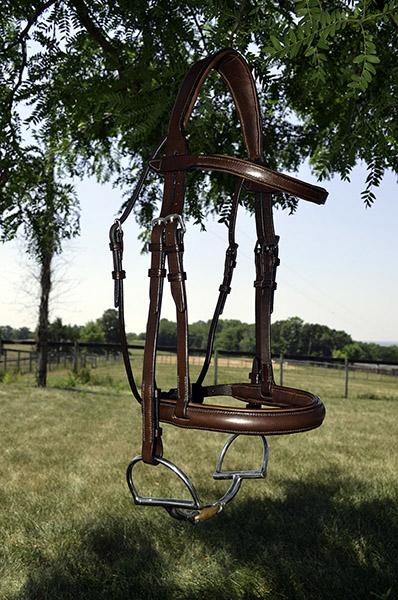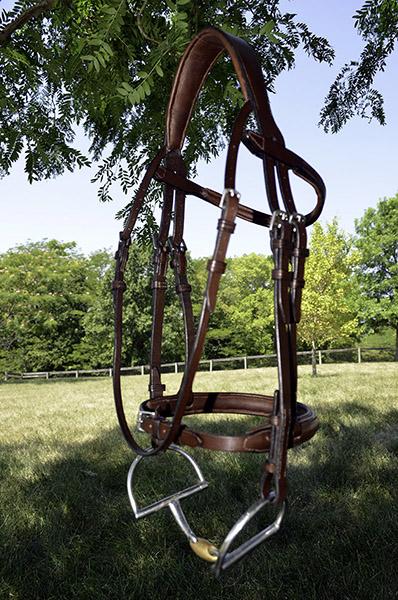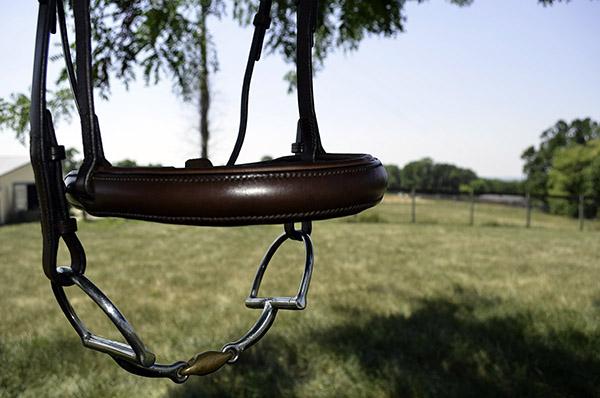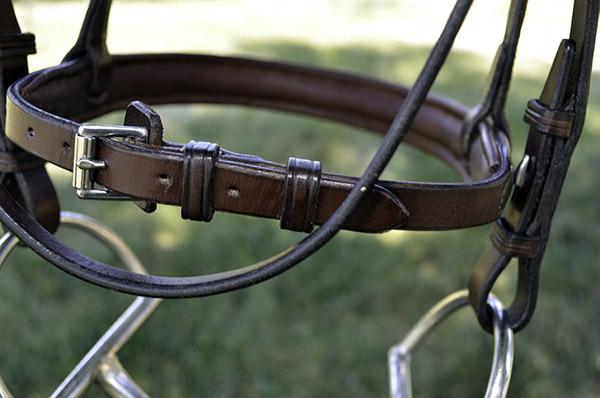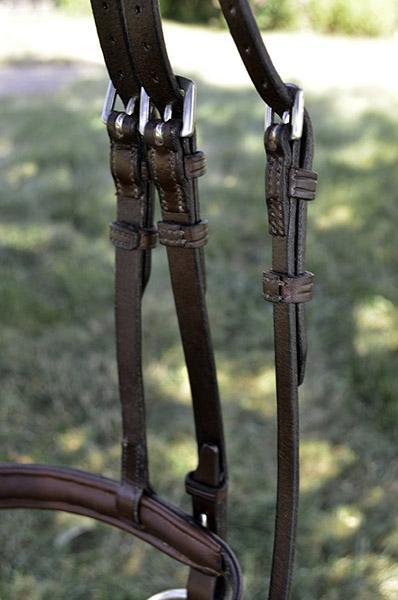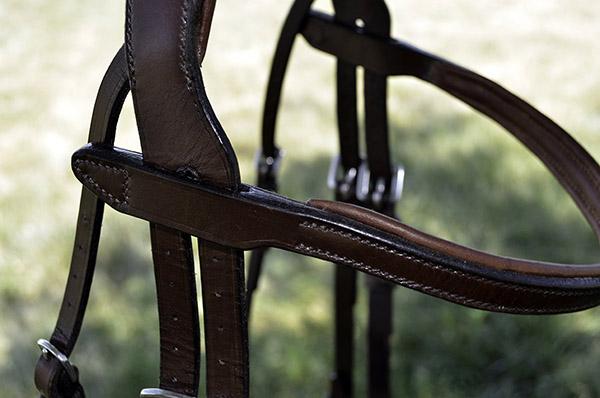-
Posts
1,282 -
Joined
-
Last visited
Content Type
Profiles
Forums
Events
Blogs
Gallery
Everything posted by TomE
-
EDIT TO SAY I DIDN'T NOTICE HOW OLD THIS THREAD IS. The leather rougher is helpful if the adhesive bond will be stressed during assembly. I use an Osborne leather rougher on the grain side of the leather filler shown here to improve the bond when making this round out of a 7 oz cover wrapped around a 9 oz filler strip. The rough surface is the grain side of the filler after roughing and coating with Barge cement. The cover is wrapped tightly around the edge of the filler piece and glued before sewing and trimming the excess filler. It is difficult to get the grain side of the filler to stick to the damp cover during assembly unless I rough the grain before gluing. Unlike a wire brush, the rougher has sharp pointed bristles that will dig into the grain and give it a suede texture without too much effort. I haven't had a problem with the Osborne rougher clogging when using on clean veg tan or bridle leather.
-
Thank you @Klara! The headpiece design is based on an Antares bridle. Thanks, @Bert03241. It's not perfect, but each one I make gets a little easier and I like it better.
-
I use a heated brass lollipop burnisher from Duane Watts. Warm the beeswax in the flame of an alcohol lamp, dab on edge, smooth and work it in with a hot burnishing iron. This video from Cary Schwartz shows the traditional Dixon style edge iron, which is hard to find.
-
I use a clicker board (red polypropylene) for cutting small pieces, and an Olfa cutting mat for squaring up hides and longer cuts. I try to modulate the pressure to decrease gouging into the cutting board/mat.
-
Finished my second bridle. Appreciate your comments and suggestions. HO bridle leather, stainless steel hardware, hand sewn with waxed #207 nylon thread. I'm trying a new-to-me edge treatment - burnishing with hot beeswax.
-
Bad kitty! Vinegar is used to neutralize cat urine odor and also to kill mold on dirty horse tack. Might be worth a try.
-
Girth straps incorporate heavy elastic webbing like this sewn to leather chapes. https://www.weaverleathersupply.com/c/product/elastic_webbing_green_1__6100_gr/6100-gr?search=true Another way to go.
-
Neat design. Smart looking piece of work.
-
The feed dog should rise above the throat plate to transport material through the machine. I like mine set at ~1/16 inch (1-2 mm) above the plate at the high point. Really like the solid feel of the narrow plate/dog on my Cobra 4.
-
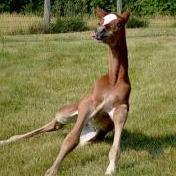
Glock 21 45 auto/ snapping turtle holster
TomE replied to Garyak's topic in Gun Holsters, Rifle Slings and Knife Sheathes
Really impressive. I guess snapping turtles are useful after all. -
Not to muddy the waters, but have you trimmed the edge square before starting the edge finishing process? With veg tan I use a round knife or piece of broken glass ("glassing the edge") to level the edge before any sanding or finishes. I normally do this before sewing, but when using a machine on a raised leather strap I sew it then trim the edge close to the stitch line.
-
Thanks, @Alexis1234 . I’ve been reading the Hasluck book on saddlery and harness making. Not complete but historical.
-
Beautiful work! I'm sure the goat will be proud to wear it. What was the vintage harness makers book you used?
-
I like the Osborne rotary and spring punches. The spring punch tubes are longer with a more gradual taper which is useful for punching through thick leather. Both types of punch tubes are removable and can be "sharpened" on a buffing wheel. They shouldn't be sharpened like a cutting blade, just polished to remove machining marks and trued up if the contact surface is uneven. The copper anvil on these punches can also be trued up with a file when it becomes grooved. The so-called punch sharpeners that bevel the inside of the punch tube will cause the leather plugs to be compressed in the tube, making them harder to eject. If a new punch is jamming I punch through oil tanned leather or a lightweight slippery plastic until inside of the tube becomes smoother.
-
Welcome! One way to center holes on a strap is to use dividers. Lightly scribe a short line on either side of center, or just press the point on either side, then punch between the marks. Scribing parallel lines is really helpful when using an oblong/bag/crew punch to orient the punch. JH Leather videos on Youtube show a lot of techniques for working with straps.
-

Comparing Edge Finishes
TomE replied to garypl's topic in Dyes, Antiques, Stains, Glues, Waxes, Finishes and Conditioners.
That sounds like a robust solution. For the Fenice Glossy PLUS edge paints they mention using a hot glazing tool in the description but I may misunderstand the application. I've read about edge stain recipes for tack that include wallpaper paste, pearl glue, or PVA glue. Seems everyone has their special sauce. I'm hoping that beeswax applied with an edge iron will create a durable seal.- 27 replies
-
- edge paint
- angelus
-
(and 1 more)
Tagged with:
-

Comparing Edge Finishes
TomE replied to garypl's topic in Dyes, Antiques, Stains, Glues, Waxes, Finishes and Conditioners.
I think the Fenice edge paints sold by Campbell Randall are all compatible with hot glazing. They are sold in 1 liter bottles. I've been using their Fenice Colorfast dye "with added waxes" on the edge of bridle leather and been very happy with the penetration and durability for tack. I don't think the Colorfast dye is compatible with glazing but it gives a nice edge IMO. I recently learned about applying beeswax with burnishing iron/edge iron in an article by Cary Schwarz in the May 2022 Shop Talk magazine. Has anyone had experience with this? I aim to try it on bridles and halters. The edge irons are hard to find so I ordered a brass "lollipop burnisher" from Duane Watts.- 27 replies
-
- edge paint
- angelus
-
(and 1 more)
Tagged with:
-
I think a burnishing iron is too big for your work. The lollipop has a 1/2 inch wide U-shaped groove. I’m planning to use it on tack made with 1-3 layers of 8-10 oz leather. I don’t know anything about the electric heated burnishers but think they are for light weight projects.
- 14 replies
-
- hidepounder
- specialty tools
-
(and 1 more)
Tagged with:
-
The burnishing iron/edge iron is heated in a flame - alcohol lamp or propane burner - or on an induction hot plate if you have a ferrous metal tool. Similar to heating a creasing iron. Beeswax is softened and spread on the edge then the warm burnishing iron is used to work the wax into the leather. Hard to find the old burnishing irons. I ordered the brass "lollipop burnisher" from Duane Watts on Etsy and am waiting to try it out. I learned about this method from an article by Cary Schwarz in the May 2022 Shop Talk magazine (I think it's Cary in the video I posted). Cary says he learned about it during a visit to sellier Jean Luc Parisot.
- 14 replies
-
- hidepounder
- specialty tools
-
(and 1 more)
Tagged with:
-

Spirit Dye Or Oil Dye
TomE replied to LAPat's topic in Dyes, Antiques, Stains, Glues, Waxes, Finishes and Conditioners.
As stated above, Fiebings leather dye and oil dye (now called Pro Dye) are both alcohol based. The pigment in the Pro Dye has been changed to resist rub off, and the difference is significant in my experience. I think there are quite a few colors of Pro Dye available. Another interesting dye is Fenice Colorfast (sold by Campbell Randall) and the related dye Fenice Diamond Waterstain (sold by Springfield Leather). These are water based dyes with added waxes. They produce good coverage and seal up the leather. I use the dark brown Colorfast fairly often when matching color for tack repairs. -
Like all Osborne tools of late, the #67 will require a fair amount of sharpening. I find that after I spend the time shaping and sharpening they are good tools - just not completely finished at the factory. This cheap knife is the one I resharpened last night and it works surprisingly well https://www.amazon.com/BANYOUR-Leather-Cutting-Working-Leathercraft/dp/B07LD4PC2D/ref=pd_lpo_1?pd_rd_i=B07LD4PC2D&psc=1. See the Harry Rogers video on cheap skiving knife.
-
Indeed! Thanks again.
-
Worked over my square Japanese style skiving knife according to HAKU video, and it is now skiving like a champ. Needed to flatten the bevel and do a better job of following the bevel when skiving. Thanks for the tips. This is the cheap Chinese skiving knife on Amazon that Harry Potter has given a favorable review. Not sure if it will hold an edge but for now it's great. JH Leather's videos have been an excellent resource as well. She's the real deal. I am on a waiting list for a small head knife from a local maker.
-
Thanks for the video. Good tips there that I will try with the square skiving knife. Not sure if this grip and angle of work is possible on a 1 inch wide strap, but I'll try it. I've found it easier to skive the narrow straps placed on the flesh side of a leather scrap instead of glass. The small strap slides all over the glass, especially true for bridle leather. I'm thinning both edges of 9 oz leather straps to about 3 oz then wet molding 2 skived straps together in a rounding block to create a swell.



